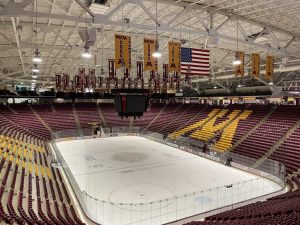Size of olympic ice rink,The size of an Olympic ice rink is a critical factor that influences the performance and safety of athletes in sports such as ice hockey, figure skating, and speed skating.

While the size can vary slightly depending on the sport and specific regulations, the International Ice Hockey Federation (IIHF) and the International Olympic Committee (IOC) have established standards that must be adhered to for Olympic competitions.
Understanding these dimensions and the reasons behind them provides insight into the design and functionality of Olympic ice rinks.
Standard Dimensions
The official size of olympic ice rink for ice hockey is 60 meters (196.85 feet) in length and 30 meters (98.42 feet) in width. This differs from the dimensions commonly found in North American rinks, which are typically 200 feet (61 meters) long and 85 feet (26 meters) wide.
The slightly larger size of the Olympic rink impacts the style of play, offering more space for skating and less physical play, as the extra width creates more room for maneuvering and passing.
For figure skating and short track speed skating, the rink used is generally the same size as for ice hockey, but the layout and markings differ to suit the specific requirements of each sport. Long track speed skating, however, is conducted on a significantly larger oval rink, measuring 400 meters (1,312 feet) in circumference, akin to the size of an athletics track.
Importance of Rink Size
The size of the ice rink is not merely a matter of tradition or aesthetic; it plays a crucial role in the dynamics of the sport. For ice hockey, a larger rink means the game emphasizes skill and strategy over physicality.
Players have more room to execute plays, making the game faster and less congested. This is in contrast to the smaller, more physical style of play seen in the National Hockey League (NHL).
In figure skating, the ample space allows skaters to perform complex jumps, spins, and footwork sequences without the risk of colliding with the boards. It also enables choreographers to design intricate routines that make full use of the ice surface, enhancing the visual spectacle of the performance.
For speed skating, the size and shape of the rink are essential for maintaining high speeds and ensuring safety. The long track’s 400-meter oval is designed to minimize the number of sharp turns, reducing the risk of falls and allowing skaters to maintain their speed.
The short track, while the same size of olympic ice rink , uses a different layout with tighter turns, making for a more intense and strategic competition.
Construction and Maintenance
Building an Olympic ice rink involves precise engineering and meticulous attention to detail. The ice must be perfectly level, with a surface that is smooth and hard. This requires a refrigeration system embedded beneath the rink to maintain a consistent temperature and prevent the ice from melting or becoming too soft.
The thickness of the ice typically ranges from 1 to 1.25 inches (2.5 to 3 centimeters), which is sufficient to support the weight of skaters while allowing for quick and efficient resurfacing between events.
Maintaining the ice surface is an ongoing process, involving the use of ice resurfacing machines, commonly known as Zambonis. These machines shave off the top layer of ice, clean the surface, and lay down a fresh layer of water that freezes to form a smooth new surface. This process is critical for ensuring the safety and performance of athletes, size of olympic ice rink as any imperfections in the ice can lead to falls or injuries.
Size of olympic ice rink

Historical Evolution
The standard dimensions of Olympic ice rinks have evolved over time. In the early 20th century, rink sizes were not standardized, leading to variations from one venue to another. As international competition became more prevalent, organizations like the IIHF and IOC established official dimensions to ensure consistency and fairness in competition.
The differences between North American and international rink sizes also reflect historical and cultural variations in the sport of ice hockey. The NHL’s smaller rinks cater to a style of play that is faster and more physical, whereas the larger international rinks emphasize skill and agility.
This distinction size of olympic ice rink remains a topic of discussion among players, coaches, and fans, particularly during international tournaments where teams must adjust to different rink sizes.